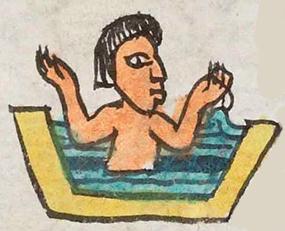Ahuilizapan (Mdz10v)
This compound glyph for Ahuillizapan has two principal elements, a man having enjoyment or pleasure (ahuilliztli) in a structured water channel or canal (apantli). He is shown in partial profile, his upper body out of the water and facing us, but his head facing to the viewer's right. His skin is a flesh tone of tan or terracotta. The water channel (apantli) in this example, in a cross-section view, has a yellow bottom and sides, a feature that recurs in many different place glyphs in the Codex Mendoza. The water channel provides the phonetic indicator for the locative suffix -apan, which mean "on the water."
Stephanie Wood
Frances Karttunen sees āhuil- (enjoyment) and ā- (water) in the graphic elements, but for the reading of the place name she points to āhuiliz- ("the act of directing water," from āhuiā, "to wield water"). Thus, the graphic for pleasure is providing the phonetic dimension of water channeling and has no semantic role.
In some contexts, ahuiliztli indicates sexual pleasure, but this is difficult to assert here. Ahuiliztli, the personal name, is typically translated today as "Joy." There is also a Ballet Ahuiliztli and a preschool with this name today in Mexico, so the sexual component is not apparently paramount.
Some water channels can be much more elaborate than this one, having both red and yellow lines on three sides and, beyond that, a green exterior frame with pairs of yellow hash marks, all containing the water (typically painted turquoise, except when another color, such as red, is being stressed).
Berdan and Anawalt explain that this town came to be called Orizaba later in time.
Stephanie Wood
ahuilizapan. puo
Ahuilizapan, pueblo
Stephanie Wood
c. 1541, or by 1553 at the latest
Stephanie Wood
Since the man appears to be half submerged and therefore inside the water, this is not really a front-to-back reading like so many glyphs with apantli.
irrigation ditch, channel, canal, waterway, playfulness, joy, fun, pleasure, leisure, water, agua, canales, riego, alegría, nombres de lugares

ahuiliz(tli), joy, pleasure, or recreation, https://nahuatl.wired-humanities.org/content/ahuiliztli
apan(tli), water channel or canal, https://nahuatl.wired-humanities.org/content/apantli
pan(tli), furrow, https://nahuatl.wired-humanities.org/content/pantli
-apan (locative suffix), on or at the waters of, https://nahuatl.wired-humanities.org/content/apan-
a(tl), water, https://nahuatl.wired-humanities.org/content/atl
-pan (locative suffix), on, https://nahuatl.wired-humanities.org/content/pan
"On the Irrigation Canals" -- In this reading, Frances Karttunen agrees with the Berdan and Anawalt translation. She does however give a different orthography for this place name, Ahuilizpan (omitting the "a" prior to the -pan locative). [Frances Karttunen, unpublished manuscript, used here with her permission.]
"On the Irrigation Canals" (Berdan and Anawalt, 1992, vol. 1, p. 170)
Ahuiliz-āpan = "En las aguas alegres" (Miguel León-Portilla); o "En los canales de riego" (SW)
Miguel León-Portilla, "Los nombres de lugar en náhuatl," Estudios de Cultura Náhuatl 15 (1982), 43.
Codex Mendoza, folio 10 verso, https://digital.bodleian.ox.ac.uk/objects/2fea788e-2aa2-4f08-b6d9-648c00..., image 31 of 188.
The Bodleian Libraries, University of Oxford, hold the original manuscript, the MS. Arch. Selden. A. 1. This image is published here under the UK Creative Commons, “Attribution-NonCommercial-ShareAlike 3.0 License” (CC-BY-NC-SA 3.0).






